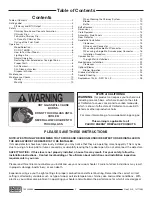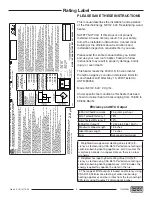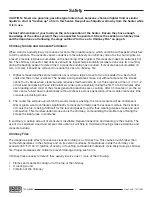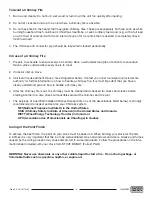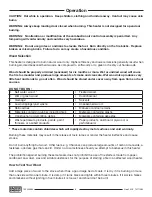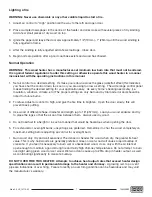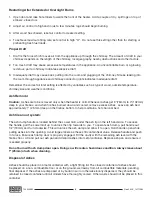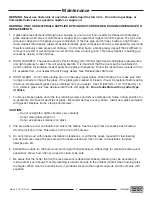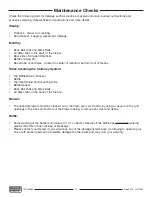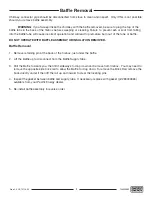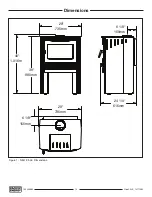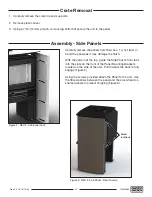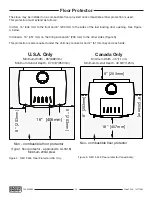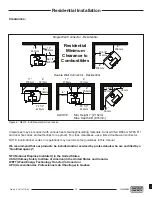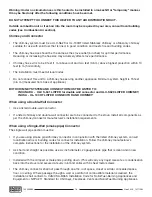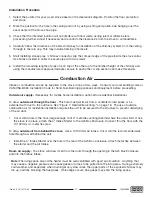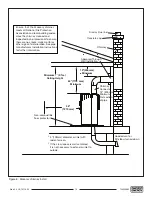
Instruct all members of your family on the safe operation of the heater. Ensure they have enough
knowledge of the entire system if they are expected to operate it. Stress the section on chimney fires
and the importance of following the steps outlined "In Case of a Chimney Fire" on page 5.
Chimney Smoke and Creosote Formation
When wood is burned slowly, it produces tar and other organic vapors, which combine with expelled moisture
to form creosote. The creosote vapors condense in the relatively cool chimney flue of a slow burning fire. As
a result, creosote residue accumulates on the flue lining. When ignited, this creosote makes an extremely hot
fire. The chimney connector and chimney should be inspected periodically (at least once every two months)
during the heating season to determine if a creosote buildup has occurred. If creosote has accumulated (3
mm. or more), it should be removed to reduce the risk of a chimney fire.
1. Highest smoke densities and emissions occur when a large amount of wood is added to a bed of hot
coals and the air inlet is closed. The heated wood generates smoke, but without ample air, the smoke
cannot burn. Smoke-free, clean burning requires small fuel loads, two or three logs at a time or 1/4 to 1/2
of fuel load and leaving the air inlet relatively wide open, especially during the first 10 to 30 minutes after
each loading, when most of the smoke generating reactions are occurring. After 30 minutes or so, the air
inlet can be turned down substantially without excessive smoke generation. Wood coals create very little
creosote-producing smoke.
2. The cooler the surface over which the wood smoke is passing, the more creosote will be condensed.
Wet or green wood contributes significantly to creosote formation as the excess moisture that is boiled
off cools the fire, making it difficult for the tars and gases to ignite, thus creating dense smoke and poor
combustion. This moisture-laden smoke cools the chimney, compounding the problem by offering the
smoke the ideal place to condense.
In summary, a certain amount of creosote is inevitable. Regular inspection and cleaning is the solution. The
use of dry, seasoned wood and ample combustion air will help to minimize annoying smoke emissions and
creosote buildup.
Chimney Fires
The dangerous side effect of excessive creosote buildup is a chimney fire. This causes much higher than
normal temperatures in the chimney and on its exterior surfaces. Temperatures inside the chimney can
exceed 2000°F (1100°C). Ignition of nearby or touching combustible material is more likely during a chimney
fire. Proper clearances are critical to prevent damage during such a fire.
Chimney fires are easy to detect; they usually involve one or more of the following:
• Flames and sparks shooting out of the top of the chimney
• A roaring sound
• Vibration of the chimney
Safety
CAUTION: Never use gasoline, gasoline type lantern fuel, kerosene, charcoal lighter fluid or similar
liquids to start or "freshen up" a fire in this heater. Keep all such liquids well away from the heater while
it is in use.
Neo 2.5LE_141119-32
4
100003380
Neo 2.5 LE_14119-32
Содержание NEO 2.5 LE
Страница 27: ...Neo 2 5 LE_14119 32 27 100003380 ...
Страница 30: ...Neo 2 5LE_141119 32 30 100003380 ...
Страница 31: ...Neo 2 5 LE_14119 32 31 100003380 ...


